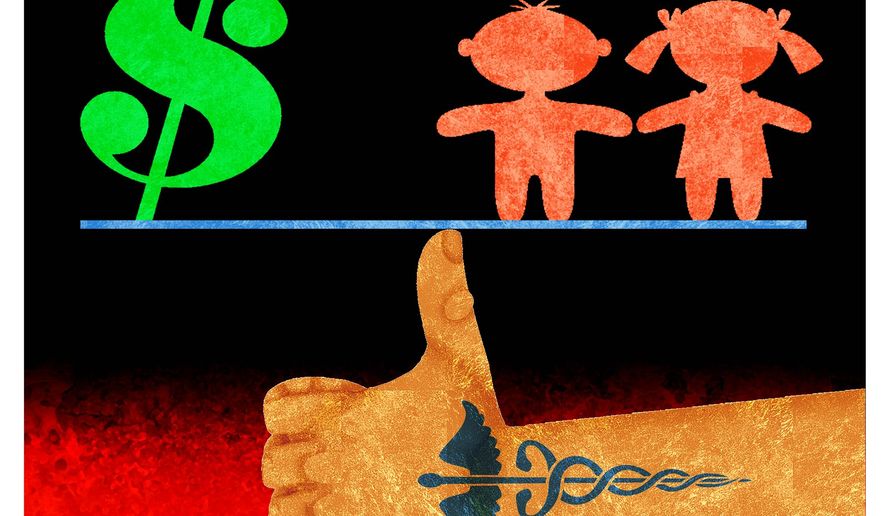OPINION:
The reasons to fear Medicare for All include losses of all kinds. It’s been estimated that as many as 2 million could lose their jobs in the health care industry. Approximately 150 million Americans insured through their employers would lose their coverage. And the coverage forced upon every American would result in a loss of freedom as the government’s one-size-fits-all policies would be your only choice.
Medicare for All proponents seek to destroy our $3.6 trillion current health care system, replacing it with sky-rocketing price tags such as Sen. Bernie Sanders’ $34 trillion plan or Sen. Elizabeth Warren’s $20.5 trillion proposal. This kind of math, however, will lead to losses of another kind — the loss of years of life my children will be allowed.
This is not a scare tactic or mere talking points. It’s a reality already set into motion.
This month, a controversial report from the Institute for Clinical and Economic Review (ICER) — a self-appointed health care-cost watchdog that puts a price tag on the lives of those struggling with sickness or a disability — specifically targeted care that helps my children who have cystic fibrosis (CF).
Like in Caesar’s Roman Coliseum where a thumbs up or thumbs down judgment determined a person’s fate, ICER’s influence on whether a life should be saved, extended or left to die is terrifyingly increasing.
ICER, which is funded heavily by the Laura and John Arnold Foundation, includes several staff with ties to the drafting of the Affordable Care Act as well as connections to broken, socialized medical care systems worldwide. This group of bean counters and economists have taken it upon themselves to create a death-panel mathematical formula that, in their perfect world, would be used to decide who receives access to life-extending medical treatments and who does not.
ICER’s formula is called Quality-Adjusted Life Years (QALY), and as noted by The Wall Street Journal, “It puts a dollar figure on a year of healthy life, calculates how much health a drug restores to a sick patient, then prices drugs accordingly … it works like this: One year spent in perfect health equals one QALY. A year with some kind of health problem that affects quality of life would be worth less than one QALY. How much less depends on the severity of the problem.”
For those with a life-long, expensive medical issue such as the CF impacting two of my four children, lives are in jeopardy if put in the hands of the ICER economists because, according to them, my children cost too much — and that’s in writing.
ICER’s latest report on CF took a look at Trikafta, a drug recently approved by the FDA that may extend the lives of my children by a decade.
Painfully unquotable, like the cold-economic — not medical — analysis it is, ICER admitted in its own report that Trikafta was highly effective yet recommended against widespread use because the annual cost of the drug wasn’t worth the extra years of life.
ICER even wrote on page 90 of the report that if Trikafta would be a cure (it’s not), it still wouldn’t be worth the money: “As an extreme scenario analysis, we evaluated Trikafta as a curative therapy and found that the cost-effectiveness ratio of lifetime therapy with Trikafta continued to far exceed commonly used cost-effectiveness thresholds even under the assumption that it maintained individuals with CF in normal health such that they never experienced any symptoms or complications of CF.”
ICER didn’t think a symptom-free day of breathing freely without worry of infection or pain was worth it.
ICER didn’t believe another day, another year, another decade with my Gunner and Gracie had value.
This judgment from people whose interests are more economic than humanitarian ignore many variables — tangible and intangible. One of the amazing things about the American medical community is the innovation and exceptionalism that has birthed life-saving care that could not have been believed in years past, as people have invested in hope and a future. Their judgment also shows little understanding of the unique nature of the rare disease drug market that serves people with diseases like cystic fibrosis.
And this perspective overlooks the value that each life holds, full of endless potential and promise. A model that looks at only what people cost and not what they are worth is destined to throw away precious human beings in favor of a fatter bottom line.
Already, countries with socialized medicine like the United Kingdom are employing this deadly math. Writing recently at The Hill, Gunnar Esiason — who also suffers from CF — noted that QALY calculations continue to be used to deny British citizens the first-, second-, and third-generation cousins of Trikafta, Kalydeco, Orkambi, Symdeko, which has extended his life.
This is what socialized medicine does — calculates how much each year it costs to keep a person alive so the government can decide what they want to spend, what that person is worth to the government.
And this reality in an ICER-like Medicare for All-controlled health care system is one that will face everyone at some point, as all will be judged by this death-panel formula. I had to explain the ICER report to my 11-year-old son, Gunner, after he overheard a phone call I was having. His face said it all. Shock and pain.
That’s a conversation none of us should have to have with their child.
• Kristan Hawkins is president of Students for Life of America. Follow her @KristanHawkins or subscribe to her podcast, Explicitly Pro-Life.




Please read our comment policy before commenting.